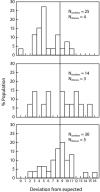Cognition from genes to ecology: individual differences incognition and its potential role in a social network
- PMID: 40252107
- PMCID: PMC12009236
- DOI: 10.1007/s10071-025-01951-4
Cognition from genes to ecology: individual differences incognition and its potential role in a social network
Abstract
There have now been many reports of intra-colony differences in how individuals learn on a variety of conditioning tasks in both honey bees and bumble bees. Yet the fundamental mechanistic and adaptive bases for this variation have yet to be fully described. This review summarizes a long series of investigations with the honey bee (Apis mellifera) that had the objective of describing the factors that contribute to this variation. Selection on haploid drones for extremes in learning performance revealed that genotype accounted for much of the variance. Neither age nor behavioral caste consistently accounted for observed variation on different conditioning protocols until genotype was controlled. Two subsequent Quantitative Trait Locus mapping studies identified a locus in the honey bee genome with a significant effect on the learning phenotype. Pharmacological and reverse genetic approaches, combined with neurophysiological analyses, confirmed that a biogenic amine receptor for tyramine affects expression of the trait. This work allowed for development of a hypothetical model of how that receptor functions in the brain to produce broad pleiotropic effects on behavior. Subsequent work used genotype as a treatment condition for evaluation of the variation under quasi-natural conditions, which revealed that individual variation reflects how foragers weigh known and novel resources in decision making. This work, together with other studies of individual differences, suggests a unifying framework for understanding how and why individuals differ in cognitive abilities.
Keywords: Genotype; Honey bee; Individual differences; Learning; Social network.
© 2025. The Author(s).
Conflict of interest statement
Declarations. Competing interests: The authors declare no competing interests.
Figures










Similar articles
-
Tyramine and its Amtyr1 receptor modulate attention in honey bees (Apis mellifera).Elife. 2023 Oct 10;12:e83348. doi: 10.7554/eLife.83348. Elife. 2023. PMID: 37814951 Free PMC article.
-
Societies to genes: can we get there from here?Genetics. 2021 Aug 26;219(1):iyab104. doi: 10.1093/genetics/iyab104. Genetics. 2021. PMID: 34849914 Free PMC article.
-
Genomic analysis in the sting-2 quantitative trait locus for defensive behavior in the honey bee, Apis mellifera.Genome Res. 2003 Dec;13(12):2588-93. doi: 10.1101/gr.1634503. Genome Res. 2003. PMID: 14656966 Free PMC article.
-
Defensive behavior of honey bees: organization, genetics, and comparisons with other bees.Annu Rev Entomol. 2004;49:271-98. doi: 10.1146/annurev.ento.49.061802.123155. Annu Rev Entomol. 2004. PMID: 14651465 Review.
-
A Multiscale Review of Behavioral Variation in Collective Foraging Behavior in Honey Bees.Insects. 2019 Oct 25;10(11):370. doi: 10.3390/insects10110370. Insects. 2019. PMID: 31731405 Free PMC article. Review.
References
-
- Benatar ST, Cobey S, Smith BH (1995) Selection on a haploid geneotype for discrimination learning performance: correlation between drone honey bees (Apis mellifera) and their worker progeny (Hymenoptera: Apidae). J Insect Behav 8(5):637–652
-
- Bhagavan S, Benatar S, Cobey S, Smith B (1994) Effect of genotype but not of age or caste on olfactory learning performance in the honey bee, apis mellifera. Animal Behaviour, pp 1357–1369
Publication types
MeSH terms
Grants and funding
LinkOut - more resources
Full Text Sources

